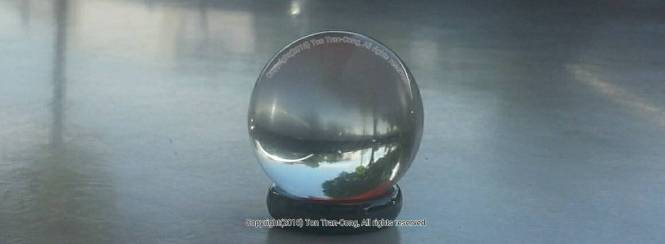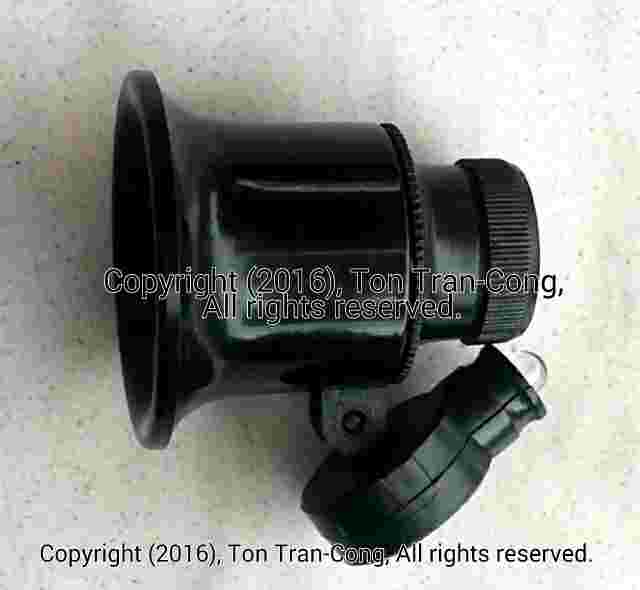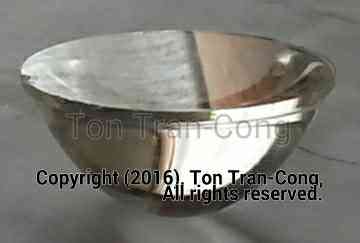Quick fire making using sunlight.
by tonytran2015 (Melbourne, Australia).
Click here for a full, up to date ORIGINAL ARTICLE and to help fighting the stealing of readers’ traffic.
(Blog No.44).
#make fire, #making fire, #fire, #Sun, #sunlight, #crystal, #glass #ball, #sphere, #lens, #ocular, #monocular #sun-rays, #survival.
You may already have in your possession some excellent lenses for making fires. Knowing about them will help you make fire quickly from sunlight when facing an emergency. All lenses described in this blog can make a cigarette smoulder in less than 30 seconds and can light up that cigarette afterwards.
1. Concentration of radiating heat flux by a lens.
The radiating heat flux from the Sun is concentrated by a factor C given by
C = Pi*d*d/(Pi*f*a*f*a) =
C = (d/f)*(d/f)*(1/a)*(1/a).
where d and f are respectively the diameter and focal length of the lenses and a is the angular diameter of the Sun (a = 0.5*3.14/180radian = 0.0087 radian).
The angular diameter of the Sun cannot be changed. It is obvious that we have to increase the ratio (d/f), which is called the aperture number of the lenses, to increase the heat flux concentration. The deciding factor for success is the aperture ratio of the mirror or lens system.
C = 13200*(d/f)*(d/f).
This concentration of heat flux is remarkably high for any lens system with D/f of more than 1/3 and can be used to ignite properly prepared tinder to make fire in survival situations.
The calculated concentration of radiating heat flux can only be achieved using precision optics. Any imperfection on the surface of the lens disperses the image of the Sun and reduces the concentration drastically.
2. A transparent perfect sphere.

Figure 1 : A small clear sphere (25mm diameter).

Figure 2 : Small clear sphere (close up view).
You may have a small clear glass sphere somewhere in your household either as a decorative item, or as a bottle stopper, etc…
The small transparent sphere I use here is a small (25.4 mm diameter) clear quartz sphere often used as an item of curiosity and often called a “crystal sphere” by fortune tellers.
Calculations using geometrical optics show that (for n=1.5) the focal point is about 0.5 radius outside the surface of the ball and the equivalent focal length of the sphere is about 2r×(3/4)= 1.5r
Even if only rays of distance less than 0.5 radius (from the central ray) converge on the spot, the aperture of the sphere is still
D/f = (2*0.5r)/(1.5r) = 1/(1.5),
a high value for aperture.
At an aperture value of 2/3, the concentration of radiating heat by sunlight is
C = 13200*(D/f)*(D/f) = 6000.
The actual aperture number of this clear sphere is higher than 1/1.5 and the sphere can be used as a lens to light up cigarettes using sunlight.
Figures 3 : Lighting a cigarette by a small 25mm clear quartz sphere.
The above photo also demonstrates the danger of leaving clear glass balls on any combustible surface. When the afternoon Sun comes down to an elevation of 41degree (= arcsin 0.6666), the image of the Sun is exactly on the combustible material and combustion becomes a real possibility !
The concentration factor of C = 6000 is only realized with a perfect sphere. For any body of revolution of nearly spherical shape, the concentration of radiating heat flux is much lower, and may come down to C = 100 when there is some appreciable astigmatism. For this reason, PRECISION IS MORE IMPORTANT THAN SIZE for transparent spheres.
I prefer having a small perfect sphere to a large approximate sphere.
3. A watchmaker double staged ocular.
Figure 1: A watch maker monocular.
Figure 2 : A watch maker monocular (rear view).
Figures 3 : Lighting a cigarette by a watch maker monocular.
A monocular is a compound magnifying lens used by watchmakers to see small details of watch movements. It is a simple version of the oculars used for each eye in common sport binoculars.
Every first aid kit for hikers should have this light weight and useful device and a pair of sharp tweezers for detecting and removal of hurting spikes or splinters sticking in the skins.
The lens nearer to the eye of a proper ocular has a large diameter to give the eye a wide field of view. The double stage makes tiny object has a large image at infinity.
When sunlight travels in the reverse direction from the back (big) end to the front (small) end it will focus at a tiny spot outside the ocular and about 20mm from the front lens.
The aperture ratio D/f of this compound lens is about 1/2.
If the dark end of a cigarette is placed at that bright tiny spot smouldering will begin in less than 1 second on a sunny day.
If the oculars of your binoculars are thread removable then you can also use them in emergency but keeping in mind that taking apart a pair of binoculars will allow dirt to contaminate it.
The concentration factor of C = 13200*(d/f)*(d/f) is only realized with a lens having perfect spherical surfaces. For any lens with only approximate shape, the concentration of radiating heat flux is much lower, and may come down to C = 100 when there is some appreciable astigmatism. For this reason, PRECISION IS MORE IMPORTANT THAN SIZE for any monocular.
I prefer to have a small quality monocular than a large one with low quality.
4. Aspherical condenser lenses.
Figure 1: A fused quartz aspherical lens.
Figure 2: Fused quartz aspherical lens viewed from another direction.
I was lucky to be given a fused quartz, thick aspheric lens. Its aperture ratio is about D/f=1/1.5 while other thin spherical, glass lenses have a ratio of less than 1/2.5.
The concentration of solar heat flux is much higher when using it than when using an ordinary magnifying glass.

Figure 3: A one battery LED torch with a thick aspherical lens at the front.
The front lenses of zoom focus LED torches are low cost substitutes for such aspherical lens. They do work exceptionally well and are even unbreakable since they are made from (acrylic ?) plastic.
Disadvantage.
The disadvantage of using any such aspherical lens for making fire is that it is heavy and it has very short distance from its flat side to the bright focal point. Sunlight coming to this bright focal point from many widely separated directions and it is difficult to direct them all to the trough of the dimple at the center of the end of a cigarette. I found that it is less easy to light up a cigarette using an aspherical lens than using a good monocular of the same diameter.
Again, it is important to also note that PRECISION IS MORE IMPORTANT THAN SIZE for any aspherical lens.
I prefer to have a small quality aspherical lens than a large one with low quality.
5. A flexible Fresnel lens for wallet.
Figure 1: A thin flexible Fresnel lens for wallet. Concentric grooves can be noticed at the right hand corners of this picture.
The lens is usually made of thin, flexible, soft clear plastic of the size of credit cards. This type of lenses is sold as wallet sized magnifying glasses for map reading.
A Fresnel lens has high aperture ratio and can be used to light up cigarettes with ease. However it needs to be properly cleaned after each use as it is easily scratched.
6. Method of lighting up a cigarette using a small lens.
1. A cigarette or its imitation made up from rolled up toilette tissue sheets with darkened ends seems to be the readily available suitable tinder sticks for making fire using sunlight.
2. A conical dimple should be made at the dark end of a cigarette. The depth of the dimple should be about the size of its radius. That is a conical concave surface should be made out of the dark flat tip of the cigarette. This tiny concave surface reduces radiating heat loss from the fire to be started at its trough.
3. A precision lens is used to focus sunlight onto the dark end of a cigarette. PRECISION IS MORE IMPORTANT THAN SIZE as the high concentration of sunlight depends on precision of the lens surface.
4. The axis of the lens system should point exactly at the Sun to have maximum amount of sunlight converging on the focal point.
5. Sunlight should be focused on one point on the surface of the dimpled end of the cigarette to blacken it. Smoke should be seen arising from the spot within 10 seconds after focusing. Other points of the surface should then be smothered to have all the surface gradually blackened.
6. Sunlight is now focused on the trough point of the dimpled surface. Smoke will be seen and the trough will glow red when assisted by gentle wind blowing toward the other end of the cigarette.
7. The cigarette should now be smoked or blown externally so that hot fume from the flame end travels toward its other end to heat up the adjacent zone to ready it for combustion.
8. A strong red glow indicates that the cigarette has been burning. It can now be used to start up a fire.
References
[1]. tonytran2015, Making fire and lighting cigarettes with sunlight, survivaltricks.wordpress.com, Making fire and lighting cigarettes with sunlight, posted on February 27, 2016
[2]. tonytran2015, Mirror for making fire using sunlight, survivaltricks.wordpress.com, Mirror for making fire using sunlight, posted on April 13, 2016
Appendix: Calculations for the spherical lens.
The focus point is about 0.5 radius outside the surface of the ball. D/f is about 0.7.
Front face
1/f = (n-1)(1/r1 + 1/r2)
f = r/(n-1)
f = 2r front
Let d be the distance from the front surface to the focal point.
d = r/(n-1) in air, rn/(n-1) in glass
d=2r in air, 3r in glass
Let d1 be the distance from the Rear surface to the focal point to.
d1 = rn/(n-1)-2r = r(-n+2)/(n-1) in glass,
r(-n+2)/(n×(n-1)) in air
d1 = r in glass, 2r/3 in air
1/d2 = 1/(2r) + (n×(n-1))/( r(-n+2) )
=(1/((2r)× (2-n)))×(2-n+2n×(n-1))
1/d2= (1/((2r)× (2-n)))× (2n*n-3n+2) for n=1.5,
1/d2 = 1/(2r) + 3/(2r)
d2 = 0.5r
Rear magnification:
0.5/(2/3) = 3/4
Equivalent focal length of the sphere is
2r×(3/4)= 1.5r
Calculations using geometrical optics show that for n=1.5 the focal point is about 0.5 radius outside the surface of the ball and the equivalent focal length of the sphere is about
2r×(3/4)= 1.5r
Aperture is
D/f=4/3.
Obviously actual parallel rays at one radius distance from the axis of the ball cannot converge on the bright spot.
Note that the radiative heat flux from the Sun is concentrated by a factor C given by
C = Pi*d*d/(Pi*f*a*f*a) =
C = (d/f)*(d/f)*(1/a)*(1/a).
where d and f are respectively the diameter and focal length of the lenses and a is the angular diameter of the Sun (a = 0.5*3.14/180radian = 0.0087 radian).
The angular diameter of the Sun cannot be changed. It is obvious that we have to increase the ratio (d/f), which is called the aperture number of the lenses, to increase the heat flux concentration. The deciding factor for sucess is the aperture ratio of the mirror or lens system.
Even if only rays of distance less than 0.5 radius converge on the spot, the aperture of the sphere is still
D/f = (2*0.5r)/(1.5r)
= 2/3 = 1/(1.5),
a high value for aperture.
At D/f of 2/3, the concentration of solar heat is
C = 13200*(D/f)*(D/f) = 6000.
PREVIOUS SURVIVAL blogs
Making fire and lighting cigarettes with sunlight. Posted on February 27, 2016

Mirror for making fire using sunlight., posted on April 13, 2016

Rice as emergency food., posted December 24, 2016
 The Orion constellation., posted December 26, 2016
The Orion constellation., posted December 26, 2016
Using GPS in off-grid situations.
Slide Sky-Disks with grid masks showing azimuths and altitudes.
Slide Sky-Map for displaying tropical stars..,,..all.
BLOG IMAGE OF SURVIVAL CONTENTS









I really like and appreciate your article post.Much thanks again. Really Great.
LikeLike
A round of applause for your blog article. Really Cool.
LikeLiked by 1 person
Reblogged this on disturbeddeputy and commented:
Fire means survival.
LikeLike
Thank you, disturbeddeputy, for re-blogging.
LikeLike
Howdy very cool site!! Guy .. Beautiful .. Wonderful
.. I’ll bookmark your website and take the feeds additionally?
I am glad to seek out numerous useful information here in the submit, we need
develop extra strategies in this regard, thanks for sharing.
. . . . .
LikeLiked by 1 person
Appreciate this post. Will try it out.|
LikeLike
Hi there, You have performed a great job. I’ll definitely digg it and in my opinion suggest to my friends. I’m confident they will be benefited from this website.|
LikeLike
Hello there, You have performed an excellent job. I will definitely digg it and for my part suggest to my friends. I am sure they’ll be benefited from this web site.|
LikeLike
Superb, what a website it is! This weblog provides useful facts to us, keep it up.|
LikeLike
Hey there would you mind sharing which blog platform you’re working with? I’m planning to start my own blog in the near future but I’m having a tough time choosing between BlogEngine/Wordpress/B2evolution and Drupal. The reason I ask is because your design seems different then most blogs and I’m looking for something completely unique. P.S Sorry for getting off-topic but I had to ask!|
LikeLike
Amazing! Its genuinely amazing article, I have got much clear idea regarding from this post.|
LikeLike
Great blog you have here.. It’s hard to find high-quality writing like yours nowadays. I really appreciate individuals like you! Take care!!|
LikeLike
Very energetic post, I enjoyed that bit. Will there be a part 2?|
LikeLike
Please let me know if you’re looking for a article writer for your blog. You have some really good posts and I think I would be a good asset. If you ever want to take some of the load off, I’d absolutely love to write some articles for your blog in exchange for a link back to mine. Please send me an e-mail if interested. Regards!|
LikeLike
Hi, I do believe this is an excellent web site. I stumbledupon it 😉 I am going to return once again since i have book marked it. Money and freedom is the best way to change, may you be rich and continue to help others.|
LikeLike
I think this is among the most important information for me. And i am glad reading your article. But want to remark on few general things, The site style is great, the articles is really nice : D. Good job, cheers|
LikeLike
Aw, this was a really nice post. Spending some time and actual effort to generate a really good article… but what can I say… I hesitate a whole lot and don’t manage to get anything done.|
LikeLike
Thanks a lot for sharing this with all of us you really realize what you are speaking about! Bookmarked. Kindly additionally consult with my site =). We may have a link trade contract between us|
LikeLike
Highly energetic article, I enjoyed that bit. Will there be a part 2?|
LikeLike
Ahaa, its nice conversation about this article here at this weblog, I have read all that, so at this time me also commenting here.|
LikeLike
[…] via Quick fire making using sunlight. — Additional survival tricks […]
LikeLike
Reblogged this on Brittius.
LikeLike
Thank you, Brittius, for re-blogging.
LikeLike
You’re welcome.
LikeLiked by 1 person